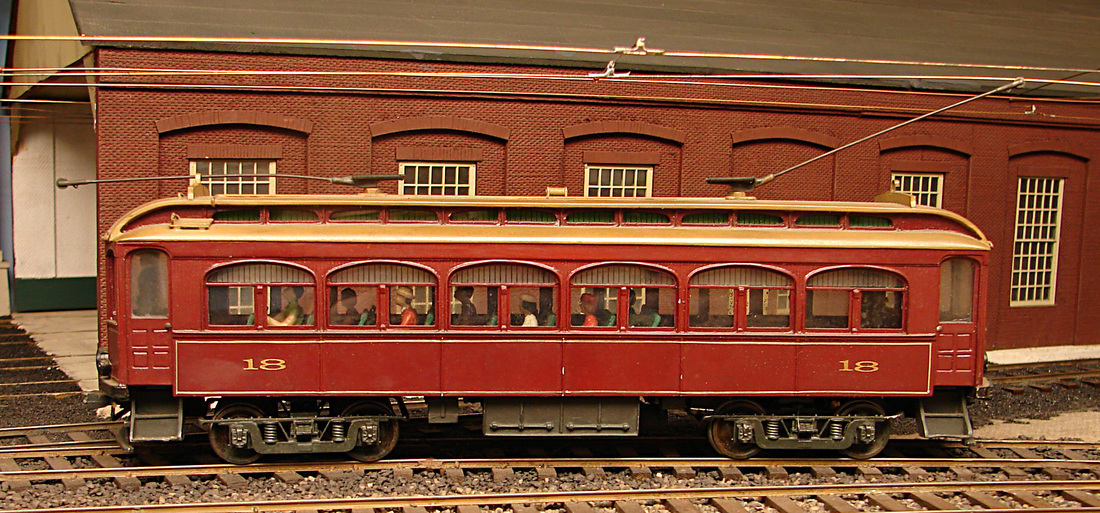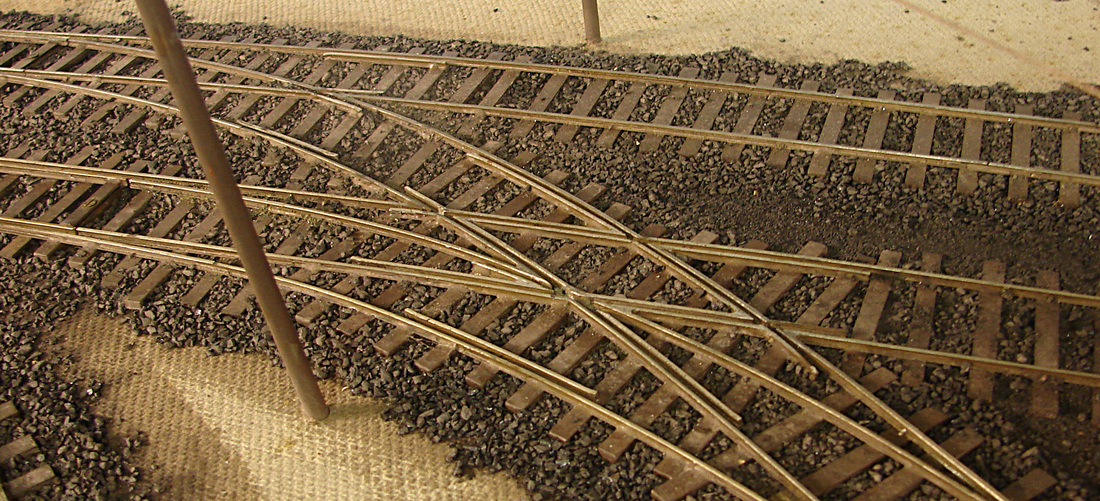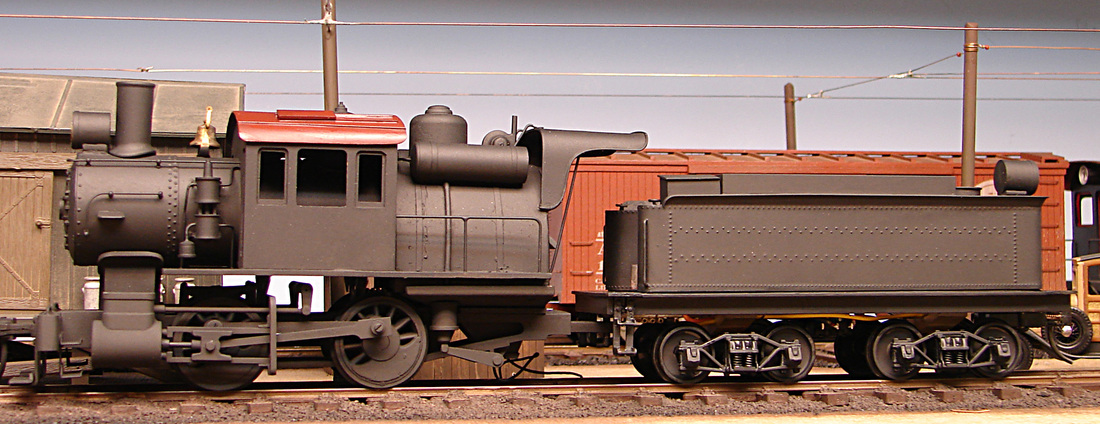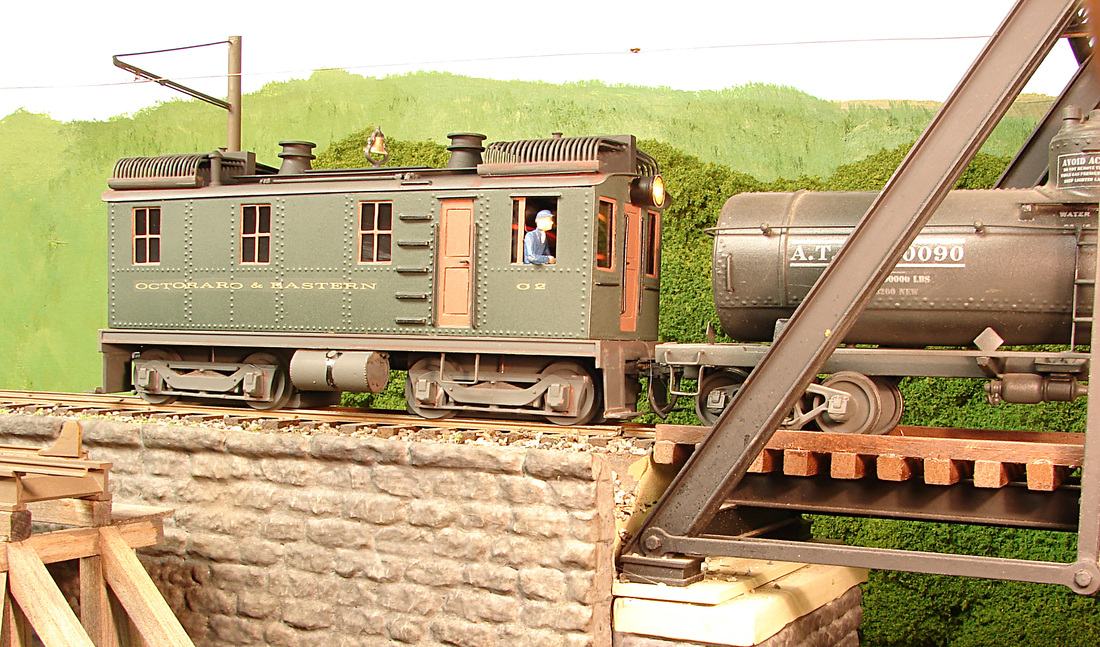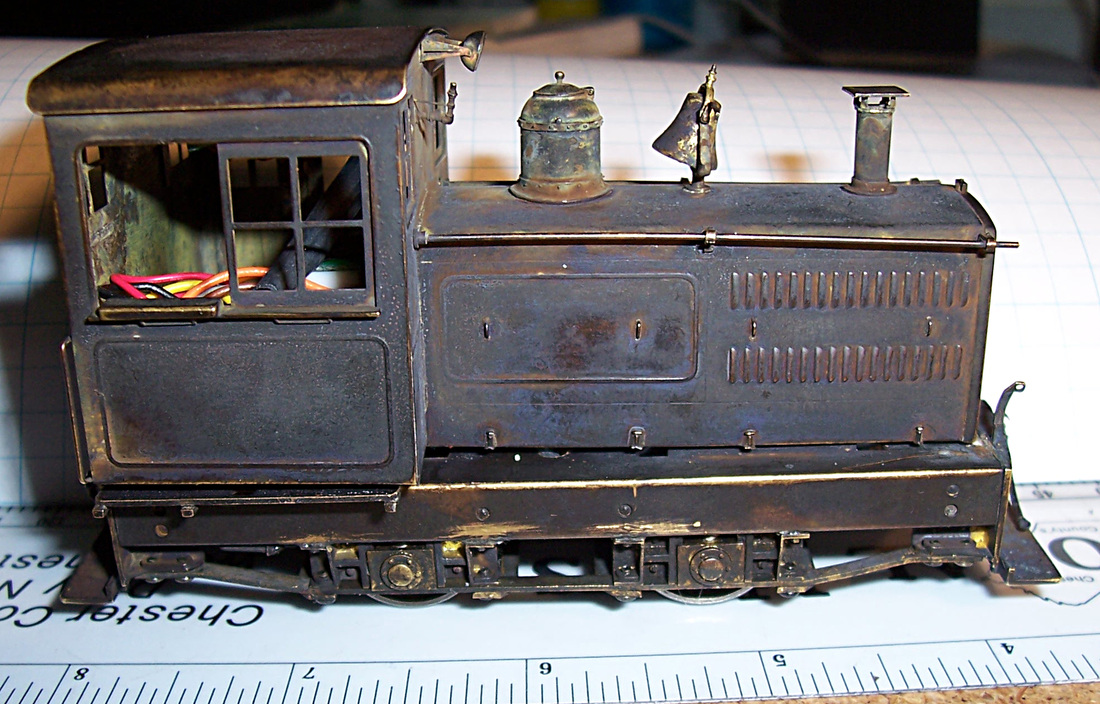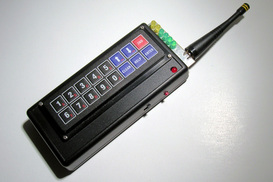Introduction
Herb Kephart was an early adopter of "Stanton stuff". His experience with S-CAB evolved along with my efforts to productize what began as systems for my own use. Products got their names as user oriented documentation was prepared and Herb's terminology carries over from his prior experience with radio control; "RC" as used for model cars and planes. "RX" is a radio transmitter; "TX" is a radio receiver. Basically, S-CAB is a hand-held TX communicating with an RX in a loco. What makes S-CAB different from RC is the RX in the loco delivers commands to a standard, commercially available DCC decoder, which controls loco motor, lights and sounds.
What follows is Herb's experience in his own words and photos.
Early Adventures with Radio Control
My interests in modeling for years has been trolleys and interurbans in O scale, so all the layouts that I built have been with both rails grounded, and overhead wire. Some 30 years ago I thought that it might be a good experiment to try putting an aircraft RX that I had into some sort of a switching loco, with batteries for power since collecting power from the rails would require totally impractical rework of track, especially switches, which had the rail soldered to brass ties.
With respect to radio, I had envisioned the RX feeding a servo which worked some sort of a transistor throttle. However, it quickly became evident that the size of NiCad batteries at the time made the whole package too large for any 0-4-0 or small diesel; so the project was shelved.
Some time went by, and I saw a system advertised for model railroad use, so I bought a package of one TX and 4RX's. The RX's were small enough that now it seemed possible with NiMh batteries this time. An assembly was lashed up as a test using a gondola car, with wires going to the loco. This was perfectly feasible and worked fine with one notable defect -- control was by pushing buttons for faster or slower. I found this to be incredibly clumsy (for me) -- coming up to a car to couple, so that the couplers just kissed was near impossible. The system went back in the box, where it remains.
First Success with Battery Power and Radio Control
Later, I discovered FreeRails, where one Woodie Greene was promoting RC with LiPo batteries, which are much smaller for a given amount of electrical capacity. Woodie was also using RX's from small RC autos and he proved that it was possible to hide the RX board and a small, but sufficient, battery in a reasonably compact space. This had my interest. I bought a 3 cell pack, and a RX board, and put them into an 0-4-0.
It did not work. Back and forth with Woodie who was very helpful, but no success. Finally, 3 RX boards later I figured that the 3-cell voltage was too much, and was instantly frying the boards as soon as the system was turned on. I called technical help at the company that sold the boards, and the 12 year old on the other end of the line had no idea what was the maximum safe voltage for the board. Big help. I tried cutting the 3 cell pack down to only 2 cells, managed to stick a #11 Exacto blade into one cell, which caused it to have a hissy fit; definitely NOT recommended.
With a new 2-cell pack, I was up and running and this system worked, with one exception. I have a scratch built brass truss bridge, which I discovered was very effective as a Faraday cage—and unless I held the TX very close to the bridge, no signal got through to the loco. Also, there was an annoying buzz from the motor, caused by the low PWM frequency. I tried to get rid of this with various capacitors across the brushes of the motor, to no avail.
First Installation of S-CAB Radio
Just at the right time, along comes Neil with a pre-production offer of a TX (a wireless throttle) and compatible RX (a radio receiver combined with a commercially available decoder) for an attractive price. I sent money off to Neil and got back what now is the S-Cab system, although I don't think the setup had that name at the time of my purchase. I installed the gear in the 0-4-0 and encountered some low speed control problems. I don't specifically remember what the loco was or wasn't doing, but things weren't right. Several Emails went back and forth with Neil. Then, he phoned and asked me to do a number of tests with the radio/decoder setup trying to get rid of the problem which just wouldn't go away.
After about 3/4 of an hour, he was running out of ideas. Suddenly, I remembered the capacitor that was connected across the motor brushes, and Neil's immediate response was "BINGO, remove the capacitor". The problem was my fault, and there was nothing wrong with the radio gear. After the call, I thought that anyone who would go to that much time and trouble to try to help out a customer was an alright guy in my book.
With the capacitor removed, the loco ran with no motor buzz and no loss of radio contact on the bridge. This loco continues to perform to my perfect satisfaction.
S-CAB Radio and BPS
Since I already had a 2-cell LiPo in the 0-4-0 loco, that installation used only S-CAB radio control. However, Neil had been developing a loco power supply which used a single cell LiPo to produce 12 volts (which became the BPS). At the same time I was building another switcher, this time an Ingersol-Rand Oil Electric, the first diesel loco to have a control circuit that didn't force the engineer to vary both throttle and generator simultaneously when starting a load.
I got a BPS and another S-Cab radio/decoder and installed it in this model. All eight wheels of the model are geared to the motor, a Maxon, about an inch in diameter. I never measured the amperage of this motor with all wheels slipping. I should -- but this whole setup has continued to meet all expectations. I admit that I was little dubious about runtime with all the power coming from a single cell, but I have never ran it long enough to have low voltage protection shut down the battery. The loco, being a switcher, never moves more than about six cars, although an informal drawbar test suggests it would pull at least 30 cars -- if I had that many! It goes through an hour and a half operating session on a single battery charge and with no power from the track.
I got a BPS and another S-Cab radio/decoder and installed it in this model. All eight wheels of the model are geared to the motor, a Maxon, about an inch in diameter. I never measured the amperage of this motor with all wheels slipping. I should -- but this whole setup has continued to meet all expectations. I admit that I was little dubious about runtime with all the power coming from a single cell, but I have never ran it long enough to have low voltage protection shut down the battery. The loco, being a switcher, never moves more than about six cars, although an informal drawbar test suggests it would pull at least 30 cars -- if I had that many! It goes through an hour and a half operating session on a single battery charge and with no power from the track.
BPS Version 2
Neil sent me the second iteration of the BPS, which will recharge from the rails and asked me to try it on powered track. He wanted me to wire the BPS so the loco could run on track power and only use the battery as a backup power supply. He figured if enough track is powered, the battery can be much smaller. Not having two rail power anywhere on the O scale line (and if I did, some of the cars do not have insulated wheel sets) I looked around for an application. I have been amassing a lot of On30 Bachmann, and also have a brass Plymouth 4 wheel critter, which I selected for the test.
With much cussing, I managed to get everything crammed inside, and an oval of HO track was put together. As I recall, the results surprised Neil. Even with the small battery, run time (loco alone) without rail power was 80 minutes. As I expected, this little critter operates flawlessly, and though I have no layout to run it on, it gets some exercise periodically on it's loop — I'll have to put a coupler on in someday so it can pull some Bachmann rolling stock.
Conclusion
I have inadvertently left the battery on and drained the battery. To remind my self not to do this, I wire the headlights to the main battery switch, Before leaving the layout, a look around tells me everything is off. I'm not keen on the battery-off push-button. So, when the critter gets pulled apart for a paint job, I'm going to substitute a small on/off switch, to break the battery circuit, which is the way I have the other locos wired. I don't use the magnetic sensor, because waving a wand over an engine that is sitting under a bunch of overhead wires (for the passenger equipment's pantographs) sounds like asking for trouble.
All in all, I'm a VERY satisfied S-CAB user.
